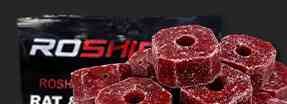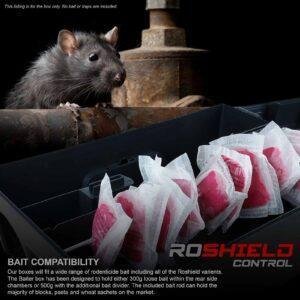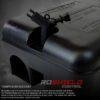

Roshield Tamper-Resistant Bait Station (Empty)
Complies with the new UK regulations for the safe use of rodenticide
No trap or rodenticide poison is included within this listing – this is for the box only.
Please select the number of boxes from the dropdown list.
Tamper-resistant bait station for the safe use of rodenticide and traps when controlling rats and house mice within both internal and external environments. Use subject to conditions on the product label and particularly when baiting around children, pets and non-target animals.
Features of our box:
- Heavy-duty, professional design
- Suitable for all sizes of rats and mice
- Lockable, prevents unauthorised access (key included)
- Made in the UK from recycled materials
All bait types can be used either by threading blocks, pasta or wheat sachets directly onto the rod or filling the rear chambers with loose bait (professional application only). The central chamber can accommodate Roshield, Romax, Kness, T-Rex, Rotech and Gorilla rat traps.
All boxes are supplied with a key, metal bait rod and instructions. We also include a bait divider to hold loose grain; however, recent regulation changes for amateur users are now intended for professional use only.
Place the box in the infestation area, bait with an appropriate attraction, and leave to allow rodents to enter. Due to neophobia (a caution of new things) it can take a while before rats and mice enter the box, this is a natural response. Leaving the box in situ all year round is recommended to allow for fast baiting when required.
It is important to note that no rodenticide or traps are included within this listing. Please see our larger combination kits if bait or traps are required.
Other than the bait rod, the box and lock contain no metal parts with the intention that it can remain in an external environment all year round.
The Roshield Baiter rodent control box has been manufactured in the UK from recycled polypropylene plastics sourced from car bumpers and dashboards. This results in a huge energy saving and lowers our carbon footprint heavily compared to similar, and less well constructed, boxes sourced from overseas suppliers.
How to use your Roshield bait box (with rodenticide or traps)
Please see the above information as to the contents included within this kit listing. Not all our kits include rodenticide or traps.
Before undertaking any rodenticide or trap control, it is important to carry out a risk assessment to highlight any hazards that may be an issue throughout the control period. Take particular note of any pets or non-target access that may be active within the area of control. When required, please take all necessary steps to prevent access, including the relocation of the box to a better location, tethering the box to a fixed item or covering it with heavy materials to limited access.
Boxes should be installed as close as possible to the rodents main food source or habitation area; however, boxes should not be placed directly in the open away from buildings. The ideal location would be against walls or sheds adjacent to their main environment. If baiting around chickens, keep the boxes to the external part of the fencing.
Several boxes may be required to control an infestation, and they should be placed in spread-out locations depending on the size and location of the activity. For best practice, place some boxes near the feed sites, and others close the habitation area.
To successfully control rodents, it is critically important that their main food source is identified and controlled. For example, if they are around a bird feeder, stop feeding the birds. If you have chickens add hoppers to control spillage.
Rodenticide:
For wheat, insert 1 packet of wheat into the bait station, either via piercing the bag and placing it onto the enclosed bait rod or, if you prefer to use the box’s lid to clamp the bag down once closed. We recommend 1 x 150g sachet per box. Check to make sure that the rodenticide is clearly fixed within the box before closing the lid.
For blocks or pasta sachets, we recommend placing several units by threading them directly onto the provided bait rod, within the range of 150g-200g would be adequate. Close the lid making sure that the contents and secure and won’t escape.
Rodents can take a while to accept box stations, so we recommend 3-4 days before initially checking the box and then every 2-4 days, depending on the consumption of the bait. It is important to continue baiting until no further activity is observed.
Traps:
Installing the trap is straightforward, and we recommend reading our instructions fully or watching one of our guidance videos. The trap should be baited with a sticky substance such as our attractant bait, peanut butter or chocolate spread. Bait the central trap cup, trigger flap and external locations around the box as this will help with trap acceptance. Set the trap with caution, making sure that no fingers are within the kill zone.
Rodents can take a while to accept the box station and the trap inside, so we recommend 3-4 days before initially checking the box and then every day subject to success. It is not advisable to leave a dead rodent within the trap to decay as this can leave negative signs to other rats.
Continue to observe the trap until no further activity is observed. Also, make sure that the bait remains inside the trap as it can be prone to smaller animals such as slugs and mice that can remove the bait without setting off the trigger. Salt at the base of the trap will help prevent this.
























